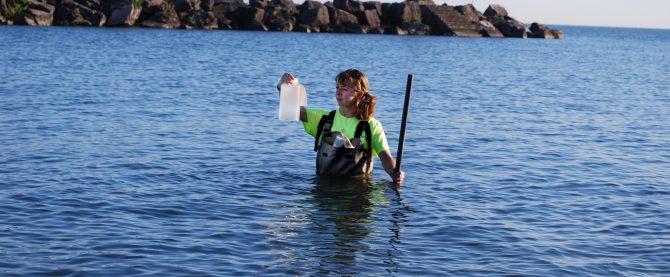NOTICE: Swimming advisory at Edgewater Beach has been lifted
Posted by John Gonzalez
- 7689 Views
- August 9th, 2018
- in Miscellaneous
- No Comments

Water quality investigators collect a beach water quality sample. NEORSD file.
Test results show bacteria levels below recreational threshold set by Ohio EPAe
Cleveland (August 9, 2018) – Test results received today, from samples taken at 10 locations near Edgewater Beach Wednesday morning, show bacteria levels below the recreational threshold set by Ohio EPA. The combined sewer overflow outfall (CSO-069) at Edgewater discharged just before midnight on Tuesday, August 7, discharging approximately 130,000 gallons of combined sewage into Lake Erie.
In addition, crews from the Northeast Ohio Regional Sewer District (Sewer District) are predicting “Good” water quality at Edgewater Beach for Thursday, August 9, and have removed the advisory signage posted on the beach earlier this week.
Sewer District crews are responsible for testing water quality at three area beaches – Edgewater Beach, Villa Angela Beach and Euclid Beach – using a rapid testing method to quickly predict whether bacteria levels in the lake are within safe limits for swimming and other shoreline activities. Due to a combined sewer overflow at Edgewater Beach (the first overflow during recreation season in three years), the Sewer District posted an advisory. Beach visitors – particularly children, the elderly and those in ill health – were advised to avoid contact with the water and debris.
Sewer District crews are predicting “Poor” water quality at Villa Angela Beach for today.
Following the combined sewer overflow at Edgewater Beach, Sewer District crews increased sampling frequency and locations. “In addition to our standard sampling at Edgewater, we have added four additional shoreline sites and five off-shore. We increased monitoring at these site to twice daily and are also monitoring lake currents and meteorological data,” said Scott Broski, Superintendent of Environmental Services at the Sewer District. “This intensive sampling plan allows the Sewer District’s environmental staff to thoroughly assess the water quality across the entire face of the beach.”
“Edgewater’s beachgoers can rest assured that our crews are out in the field daily during beach season to ensure their safety. If the water’s bacteria levels are too high, we want the public to know,” said Frank Greenland, Director of Watershed Programs. “Through our continued infrastructure improvements, we are committed to keeping our Great Lake great and wouldn’t settle for anything less.”
Since 1972, the Sewer District has reduced the volume of CSO by half – from 9 billion gallons to 4.5 billion gallons – and continues efforts to reduce CSO from entering local waterways. The Sewer District has $3 billion plan – Project Clean Lake – which will further reduce overflows from 4.5 billion gallons to 500 million gallons by 2035 through the construction of large-scale storage tunnels, green infrastructure and wastewater treatment plant upgrades.
Project Clean Lake – the Sewer District’s 25-year, $3 billion capital improvement plan – will reduce combined sewage entering Lake Erie and other area waterways. In addition to increased capacity at the Sewer District’s three wastewater treatment plants, Project Clean Lake will include the construction of large storage tunnels designed to capture combined sewage and convey it to a treatment plant for full treatment. The Sewer District currently has two tunnels in operation: Euclid Creek Tunnel’s flows are treated at the Easterly Wastewater Treatment Plant and Mill Creek Tunnel’s flows are treated at the Southerly Wastewater Treatment Plant. Three additional tunnels – Dugway Storage Tunnel, Dean Valley Tunnel and Westerly Storage Tunnel – are currently under construction.
Throughout the mid-1970s, the combined sewer outfall at Edgewater Beach discharged raw sewage into Lake Erie approximately 40 to 50 times per year. However, because of the Sewer District’s improvements to aging infrastructure, the Edgewater combined sewer overflow discharges have significantly decreased: the overflow, on average, discharges only once every few years. The last Edgewater discharge (during recreation season) was June 27, 2015.
Daily results are posted to http://neorsd.org/beaches and available via Twitter @NEORSDbeaches.
